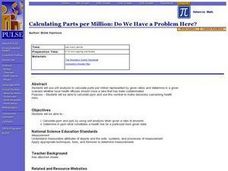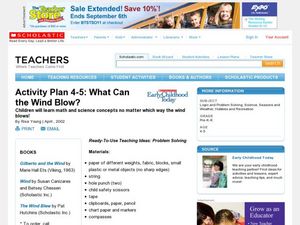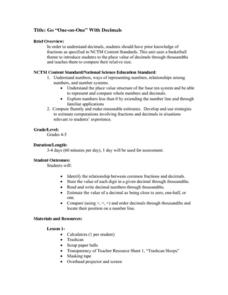Curated OER
How Light Moves
Young scholars study the movement of light. In this light lesson, students work in groups to participate in a light and shadow walk around their neighborhood. Young scholars brainstorm rules for light movement and watch videos about...
Curated OER
Shapes (Orienteering)
Students explore the tools of navigation. In this shapes lesson, students navigate using direction cues to create a shape. Students follow specific steps to create their shapes. Students use compasses to see the directions...
Curated OER
Calculating Parts per Million: Do We Have a Problem Here?
Students calculate ppm and ppb by using unit analysis when given a ratio of amounts.
They determine in ppm what constitutes a health risk for a particular toxin given data
and whether local health officials should close a lake...
Curated OER
What Can the Wind Blow?
Students observe math and science concepts no matter which way the wind blows. In this early childhood problem solving instructional activity, students will develop science, math, and observation skills as they learn about the wind.
Curated OER
Magnets in a Bag
Fifth graders compare and contrast the patterns that they create using iron fillings and different types of magnets.
Curated OER
Beef or Dairy?
Guernsey, Jersey, Holstein. Brangus, Charoloais, Herford. Here’s a truly cross-curricular resource that combines language arts, science, math, and visual arts activities as class members learn to distinguish between beef and dairy...
Curated OER
Move It! With Simple Machines
Students explore engineering by participating in a mechanical class activity. In this simple machines lesson, students identify many simple machines that allow them to perform tasks easily each day. Students collaborate in small groups...
Curated OER
Binaural Hearing in Humans
In this creative science activity from Scientific American, students learn more about hearing with two ears and make a hands-on exploration of how sound is located. Excellent web link resources are also provided.
Curated OER
The Ogre Bully
First graders complete activities with the story The Ogre Bully. In this literature lesson, 1st graders discuss opposite words and then read the story. They answer questions for comprehension and complete phonics activities and...
Curated OER
Objects of Adornment
Young scholars examine the portrait of two historical princesses. In this art history lesson, students define the term "adornment" and discuss the characteristics of each painting. Young scholars compare and contrast the objects worn by...
Curated OER
The Gingerbread Person
Students discuss gender bias and stereotyping. In this social science lesson plan, students read the book "The Gingerbread Boy" and discuss why it is a boy. Students then write their own story changing it to a gingerbread girl and a...
American Museum of Natural History
Solar System Scavenger Hunt
Scholars go on a hunt to locate objects that best fit the measurements to create an eye-catching scale model of the solar system.
DiscoverE
Rocket-Powered Ski Lift
If a ski lift had rockets, imagine how fast it would be! Scholars let their imaginations take flight as they build models for such a ski lift. Rather than using a rocket, though, they'll use a much safer balloon as the power source.
Biz Kids
Understanding Business Ethics
After screening an episode by BizKids, scholars show what they know about business vocabulary, then take part in grand conversations about role models and ethical dilemmas.
National Park Service
The Young Naturalist
Beginning with a brief history of our 26th president, Theodore Roosevelt, then followed by a discussion of his interest in nature, young scientists take to the outdoors to locate and observe local plants and insects....
California Education Partners
My Five Senses by Aliki
An assessment designed to examine scholars' reading comprehension skills takes place over three days. Starting with a read-aloud of My Five Senses by Aliki, learners then take notes and discuss their most memorable moments with...
California Education Partners
Follow the Water by Arthur Dorros
Assess scholars' reading and writing capabilities with an exam that challenges learners to respond to an informative text. Through note-taking and peer discussion, pupils analyze a passage from the story, Follow the Water from Brook to...
American Museum of Natural History
Microbes Coloring Book and Scavenger Hunt
Coloring pages showcase microbes—bacteria, viruses, and protists. Scholars have the option to download a coloring book and scavenger hunt or color the page directly on the computer. Three paragraphs describe each microbe.
National Security Agency
Go One-on-One with Decimals
Shoot and score with three basketball-themed lessons about decimals. Young mathematicians compare game statistics, make trash can hoops, and play a data spinner game to practice identifying digits and values within decimal numbers.
Curated OER
Amos and Boris: Text Study
Twenty insightful questions follow a read aloud of the story, Amos and Boris by William Steig. Scholars then show what they know through completion of a cause and effect chart, reading fluency assessment, and a written...
DiscoverE
Electrical Liquids
Liquid or not, here comes the electricity. Scholars test the conductivity of various substances using a circuit that includes a light bulb. If the light bulb lights up, then the liquid is a conductor. What a bright idea!
Curated OER
Wire Maze
Students investigate what causes electrical circuits to work. They construct a wire circuit and pass a paperclip through the maze, trying not to touch the wire, and answer discussion questions.
Curated OER
Breaking it Down
Students discover how water expands when frozen during a glacier. In this matter lesson, students fill a glass jar with water, leaving no room for air in the jar and place it in the freezer. Students retrieve the jar and notice the...
Curated OER
No Creation-No Destruction--All in a Baggie
Students investigate the concepts of conservation of mass and simple chemical reactions. Students complete lab experiments and record all observations as well as conduct experiments on their own to determine which reactions created...























